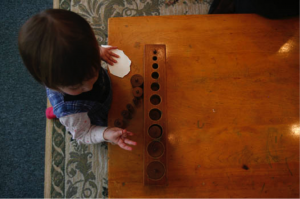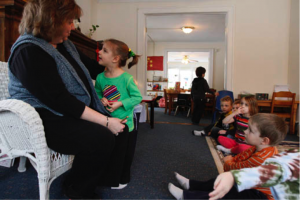CURRICULUM
The Montessori environment contains four basic areas of curriculum: Practical life/Daily living, Sensorial, Math, and Language. It is enriched with Art, Geography, Science, French, Music, and Movement.
Practical Life exercises are everyday life activities which form a link between home and school. They include such exercises as hand washing, polishing shoes, metal and wood, and dressing frames for practicing such everyday routines as buttoning and tying. These activities assist development of controlled and coordinated movements, concentration, independence and the completion of an activity. They also form the foundation for the later work in the Montessori classroom.
Sensorial materials help your child to classify and understand all that he takes in through the senses. Each of the sensorial materials isolates one quality such as texture , size, shape, color or sound. The child’s full attention is focused on that quality. It is the aim of Montessori to not only introduce the child to new impressions, but also to help him understand those things that he is exposed to everyday.
Math: Dr. Montessori demonstrated that if children have access to mathematical equipment in their early years, they can easily and joyfully assimilate many facts and skills of arithmetic.
Montessori gives the child concrete objects for the hand in order to help the understanding. The math equipment isolates one concept for the child to absorb. The materials are concrete and represent all types of quantities which the child is free to manipulate as he counts. He not only sees the quantities for 1,10,100, etc., but he can hold them in his hand. Later, he is shown the written symbols, or number for that quantity. When the child is ready for mathematical operations like addition, he can actually perform the operation with the concrete materials. There are a variety of materials the child can use for the same operation. This variety not only maintains the child’s interest but allows for much repetition. In this way, the child gains a true understanding of the operation.
Language: The Montessori language material helps the child to classify his world by broadening his vocabulary. Through pictures and real objects the vocabulary is materialized. Reading begins when the child is introduced to the sounds of the letter. Next, he is given the letter for that sound and finally, he is shown how to put the sounds together to form words. Reading and writing are introduced simultaneously in the environment and the child develops these skills throughout the curriculum.
CLASSROOM COMMUNITY
Montessori philosophy fosters a natural sense of community in addition to a respect for each individual. In the classroom, the children are given freedom of choice within a well-defined set of ground rules. These rules have been carefully established to provide fair and clear expectations for the working community, along with a consistent set of guidelines and consequences for one’s actions. The teachers, assistants and children work cooperatively to provide a safe, comfortable, and just environment in which to grow and learn.
COMMUNICATION
We are always available to discuss any concerns you may have, when the children are not our immediate responsibility. We ask that you write a note requesting a conference time or a phone call and we will be happy to accommodate you. Unless there is an emergency, it is requested that calls not be made to the teachers during class time. Since the children are our primary focus during class time, the answering machine may record a message which will be checked periodically, and your call will be returned promptly.
There will be a parent meeting during the year regarding Montessori philosophy, materials and other social and developmental issues. There will be time set aside for parents to gather and visit while your child is in school. We will advise you of these times well in advance. In the interest of keeping parents informed of themes, plans or events in the classroom, we will issue periodic newsletters. We will have Parent Teacher conferences in January to discuss your child’s growth and plans for the following school year.
“Scientific observation has established that education is not what the teacher gives; education is a natural process spontaneously carried out by the human individual, and is acquired not by listening to words but by experiences upon the environment.”
“Our aim is not merely to make the child understand and still less to force him to memorize, but to touch his imagination as to enthuse him to his inmost core.”


